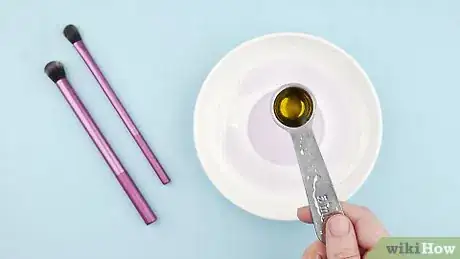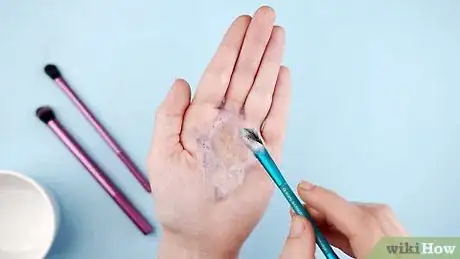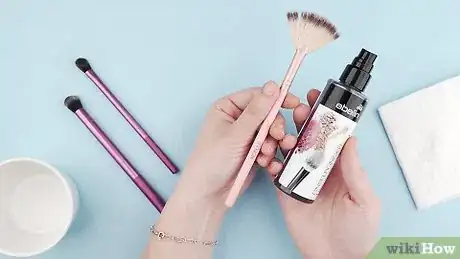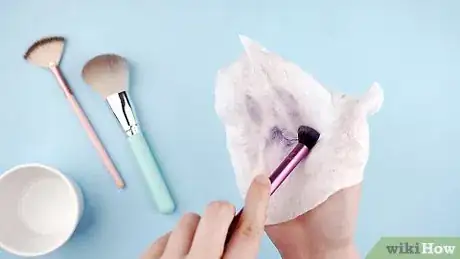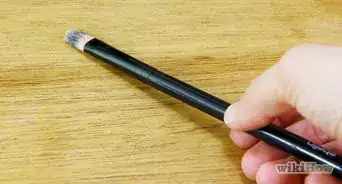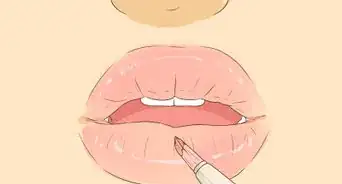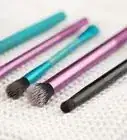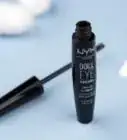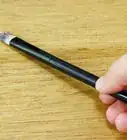This article was co-authored by Yuka Arora. Yuka Arora is a self-taught makeup artist who specializes in abstract eye art. She has been experimenting with makeup art for over 5 years, and has amassed over 5.6K Instagram followers in just 5 months. Her colorful and abstract looks have been noticed by Jeffree Star Cosmetics, Kat Von D Beauty, Sephora Collection, among others.
There are 7 references cited in this article, which can be found at the bottom of the page.
This article has been viewed 78,460 times.
Whether you use professional makeup brushes or cheap ones, it’s important to always keep them clean. Cleaning makeup brushes with olive oil and soap is a relatively easy process. Keeping your brushes clean will protect your skin, and the brushes will last longer too!
Steps
Washing Makeup Brushes with Olive Oil and Soap
-
1Use a good quality extra virgin oil in addition to gentle dish soap. If you really want to clean makeup brushes thoroughly, adding olive oil into the soap can really finish the job. The oil will break down any of the makeup that has built up over time.
- To clean makeup brushes, you will need a medium to large dinner plate (not paper). Start by adding the dish soap and olive oil to the plate in a 3:1 ratio - roughly 3 teaspoons (15 ml) of soap to 1 teaspoon (5 ml) of oil.
- Instead, you could pour a small amount of olive oil into a bowl (a little more than enough to cover the bottom of the bowl). This should be enough oil for two or three brushes depending on their size.[1]
-
2Swirl your brush into the oil. Gently swirl your brush around on the plate until the bristles are coated with the mixture. You may find it easier to dampen the bristles slightly with lukewarm water before doing this.
- You must use extra virgin olive oil. It contains the most deeply moisturizing properties of suitable oils. Other highly moisturizing oils are too thick and will leave residue on the bristles. Or, dip your makeup brush into the bowl.
- Continue to swirl the brush, or sweep side-to-side if it is a flat brush, on the back of your hand until the bulk of the cosmetic residue is gone. Rinse the brush and your hand in lukewarm (not hot) water, and repeat until the bristles are clean, and the suds are pure white.
Advertisement -
3Add dish soap after you are done with the olive oil treatment (or shampoo). Using dish soap is important because it will remove the oils. An alternative method is to mix two parts antibacterial dish soap to one part of the extra-virgin olive oil on a clean plate, and use them at once (again, don't use paper plate, as the oil will seep through).
- Squirt a little bit of the dish soap or shampoo into the palm of your hand, and swirl your makeup brush on your palm creating a little bit of lather (shampoo is best for natural bristle makeup brushes). Dish soap is great because it is specially formulated to break down oils, and it is antibacterial (this is great for people with sensitive skin and stubborn acne).
- This will leave your brushes feeling squeaky clean. Turn on the tap, and continue scrubbing the brush on your palm under warm running water until you can no longer see any product coming out of your brush. This is a technique commonly used to clean paint brushes, but it works just as well with most makeup brushes.
-
4Consider investing in a brush cleaner. Department stores sell cleaners that are specifically made for makeup brushes.
- It might be worth investing in one if you wear makeup on a daily basis. Heavy makeup users need to clean their brushes more often.
- Makeup brush cleaner is more hygienic and safer for your brushes (and skin) especially if you have expensive brushes.
Washing Makeup Brushes With Dish Soap Only
-
1Develop a regular cleaning process. It’s a good idea to regularly wash your brushes. Some people even suggest you do so every day if you are a heavy makeup user. Once a week can work too.[2]
- Old makeup, sebum, and general debris in the air create a breeding ground for bacteria inside the nest of bristles of makeup brushes. Not only is this unsanitary and generally unsettling to most people, but it can potentially cause acne and irritation if used on your face again.
- Regardless of when you wear makeup, it is advisable that you regularly clean any brushes used to apply creams and liquids or that are used around the lips and rim of the eyes. This also preserves the longevity of your brushes.
-
2Remove any obvious product from the brushes first. It will be easier to clean the brushes if you shake or wipe off any obvious makeup clumps from the brushes first.
- Take off whatever product you can by hand (maybe flick the bristles or wipe them on something, like a paper towel) before rinsing the brushes thoroughly with warm water. This should remove the bulk of the product from the brushes.
- Clean your makeup brush as soon as you get the chance. It will be harder to clean the brushes if you let them dry with the product still on them. Cleaning your brushes is good for your skin.
-
3Choose anti-bacterial dish washing soap or body wash (the liquid kind works best). A small pea-sized amount in the palm of your hand should do. You could also use baby shampoo.[3]
-
4Repeat the process if there is still product on the brushes. Sometimes, you may need to wash a brush more than one time to get it clean.
- Put more soap on the brushes, and wash them again. You could also put a squirt of soap in with some warm water, and leave your brush ends in it.
- Do not leave them in the water for more than an hour because it sometimes messes with the shape. If you have wood handled brushes, leaving them in water too long could cause them to split.
Drying Your Makeup Brushes
-
1Dry the brushes in the air. Once you've turned off the tap, squeeze as much water out of your brush as you can (while still being gentle to your brush just like before). Spike up the bristles, so they are all going in the correct direction.
- Leave the brushes in a glass or container, and let them stand upright with the bristles in the air (make sure no soap is still on them before you do so), and then leave them overnight or for however long it takes them to dry.
- Don't put them into cases or let them dry while they are pressed against something as it will bend the shape of the bristles, so air drying is the best.[6] By standing them upright, the water drains down and away, and they can form to their natural shape.
- Once dry, just flick the bristles a little to soften them up. You could roll a dish towel like you would a yoga mat, and drape a paper towel over it so that most of the paper towel hangs off (the paper towel should look like a slide coming down from the dish towel). Next, arrange the brush so the top of the handle sits on top of the towel, pitching the rest of the brush down onto the paper towel. This will allow your brushes to dry on a slant.
- You could also dry your brushes by either lying them flat on a clean towel or microfiber cloth to dry or, optionally, hanging them straight down from a clothes hanger with clothespins gripping the ends of the handles.[7]
-
2Avoid anything that will harm your makeup brushes. You want to take steps that will reduce harm to the brushes while you clean them.
- Never rinse your brushes in hot water; it will loosen the glue holding the bristles in place and cause them to shed.
- Never lay brushes to dry with the bristles higher than the handle. Water will run back into the barrel (the metal casing connecting the bristles to the handle) and loosen the glue holding the bristles.
- For double-ended brushes, lay perfectly flat to dry. For specialty applicators, use specialized cleaners suggested by the manufacturer to preserve the quality of the material.
Community Q&A
-
QuestionCan I use vegetable oil instead of olive oil?
 Community AnswerYes, but it doesn't work as well. It may also leave a thin film over all the brush and then the makeup will cake when you try to put it on.
Community AnswerYes, but it doesn't work as well. It may also leave a thin film over all the brush and then the makeup will cake when you try to put it on.
References
- ↑ https://www.youtube.com/watch?v=dZmmR32nrLM
- ↑ http://www.elle.com/beauty/makeup-skin-care/news/a15532/how-to-clean-makeup-brushes/
- ↑ https://intothegloss.com/2015/04/how-to-clean-makeup-brushes/
- ↑ http://www.popsugar.com/beauty/How-Clean-Makeup-Brushes-24424735
- ↑ Yuka Arora. Makeup Artist. Expert Interview. 30 August 2018.
- ↑ http://thebeautydepartment.com/2012/09/how-to-properly-wash-your-brushes/
- ↑ https://www.youtube.com/watch?v=oN31xXnDK5A
